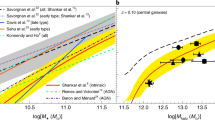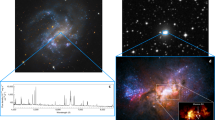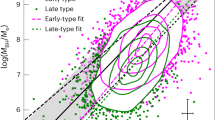Abstract
The masses of supermassive black holes are known to correlate with the properties of the bulge components of their host galaxies1,2,3,4,5. In contrast, they seem not to correlate with galaxy disks1. Disk-grown ‘pseudobulges’ are intermediate in properties between bulges and disks6; it has been unclear whether they do1,5 or do not7,8,9 correlate with black holes in the same way that bulges do. At stake in this issue are conclusions about which parts of galaxies coevolve with black holes10, possibly by being regulated by energy feedback from black holes11. Here we report pseudobulge classifications for galaxies with dynamically detected black holes and combine them with recent measurements of velocity dispersions in the biggest bulgeless galaxies12. These data confirm that black holes do not correlate with disks and show that they correlate little or not at all with pseudobulges. We suggest that there are two different modes of black-hole feeding. Black holes in bulges grow rapidly to high masses when mergers drive gas infall that feeds quasar-like events. In contrast, small black holes in bulgeless galaxies and in galaxies with pseudobulges grow as low-level Seyfert galaxies. Growth of the former is driven by global processes, so the biggest black holes coevolve with bulges, but growth of the latter is driven locally and stochastically, and they do not coevolve with disks and pseudobulges.
This is a preview of subscription content, access via your institution
Access options
Subscribe to this journal
Receive 51 print issues and online access
$199.00 per year
only $3.90 per issue
Buy this article
- Purchase on Springer Link
- Instant access to full article PDF
Prices may be subject to local taxes which are calculated during checkout


Similar content being viewed by others
References
Kormendy, J. & Gebhardt, K. in Proc. 20th Texas Symp. Relativ. Astrophys. (eds Wheeler, J. C. & Martel, H. ) 363–381 (American Institute of Physics, 2001)
Ferrarese, L. & Merritt, D. A fundamental relation between supermassive black holes and their host galaxies. Astrophys. J. 539, L9–L12 (2000)
Gebhardt, K. et al. A relationship between nuclear black hole mass and galaxy velocity dispersion. Astrophys. J. 539, L13–L16 (2000)
Tremaine, S. et al. The slope of the black hole mass versus velocity dispersion correlation. Astrophys. J. 574, 740–753 (2002)
Gültekin, K. et al. The M–σ and M–L relations in galactic bulges, and determinations of their intrinsic scatter. Astrophys. J. 698, 198–221 (2009)
Kormendy, J. & Kennicutt, R. C. Secular evolution and the formation of pseudobulges in disk galaxies. Annu. Rev. Astron. Astrophys. 42, 603–683 (2004)
Hu, J. The black hole mass–stellar velocity dispersion correlation: bulges versus pseudo-bulges. Mon. Not. R. Astron. Soc. 386, 2242–2252 (2008)
Nowak, N. et al. Do black hole masses scale with classical bulge luminosities only? The case of the two composite pseudo-bulge galaxies NGC 3368 and NGC 3489. Mon. Not. R. Astron. Soc. 403, 646–672 (2010)
Greene, J. E. et al. Precise black hole masses from megamaser disks: black hole–bulge relations at low mass. Astrophys. J. 721, 26–45 (2010)
Ho, L. C. (ed.) Coevolution of Black Holes and Galaxies (Carnegie Observatories Astrophys. Ser. 1, Cambridge Univ. Press, 2004)
Silk, J. & Rees, M. J. Quasars and galaxy formation. Astron. Astrophys. 331, L1–L4 (1998)
Kormendy, J., Drory, N., Bender, R. & Cornell, M. E. Bulgeless giant galaxies challenge our picture of galaxy formation by hierarchical clustering. Astrophys. J. 723, 54–80 (2010)
Toomre, A. in Evolution of Galaxies and Stellar Populations (eds Tinsley, B. M. & Larson, R. B. ) 401–426 (Yale Univ. Observatory, 1977)
Sanders, D. B. et al. Ultraluminous infrared galaxies and the origin of quasars. Astrophys. J. 325, 74–91 (1988)
Hopkins, P. F. et al. A unified, merger-driven model of the origin of starbursts, quasars, the cosmic X-ray background, supermassive black holes, and galaxy spheroids. Astrophys. J. Suppl. Ser. 163, 1–49 (2006)
Barth, A. J., Greene, J. E. & Ho, L. C. Dwarf Seyfert 1 nuclei and the low-mass end of the M BH–σ relation. Astrophys. J. 619, L151–L154 (2005)
Greene, J. E. & Ho, L. C. The M BH–σ* relation in local active galaxies. Astrophys. J. 641, L21–L24 (2006)
Greene, J. E., Ho, L. C. & Barth, A. J. Black holes in pseudobulges and spheroidals: a change in the black hole–bulge scaling relations at low mass. Astrophys. J. 688, 159–179 (2008)
Bentz, M. C., Peterson, B. M., Pogge, R. W. & Vestergaard, M. The black hole mass–bulge luminosity relationship for active galactic nuclei from reverberation mapping and Hubble Space Telescope imaging. Astrophys. J. 694, L166–L170 (2009)
Woo, J.-H. et al. The Lick AGN monitoring project: the M BH–σ* relation for reverberation-mapped active galaxies. Astrophys. J. 716, 269–280 (2010)
Ho, L. C. Nuclear activity in nearby galaxies. Annu. Rev. Astron. Astrophys. 46, 475–539 (2008)
Filippenko, A. V. & Ho, L. C. A low-mass central black hole in the bulgeless Seyfert 1 galaxy NGC 4395. Astrophys. J. 588, L13–L16 (2003)
Peterson, B. M. et al. Multiwavelength monitoring of the dwarf Seyfert 1 galaxy NGC 4395. I. A reverberation-based measurement of the black hole mass. Astrophys. J. 623, 799–808 (2005)
Barth, A. J., Strigari, L. E., Bentz, M. C., Greene, J. E. & Ho, L. C. Dynamical constraints on the masses of the nuclear star cluster and black hole in the late-type spiral galaxy NGC 3621. Astrophys. J. 690, 1031–1044 (2009)
Thornton, C. E., Barth, A. J., Ho, L. C., Rutledge, R. E. & Greene, J. E. The host galaxy and central engine of the dwarf active galactic nucleus POX 52. Astrophys. J. 686, 892–910 (2008)
Hopkins, P. F. & Hernquist, L. Fueling low-level AGN activity through stochastic accretion of cold gas. Astrophys. J. Suppl. Ser. 166, 1–36 (2006)
Yu, Q. & Tremaine, S. Observational constraints on growth of massive black holes. Mon. Not. R. Astron. Soc. 335, 965–976 (2002)
Schawinski, K. et al. Galaxy zoo: the fundamentally different co-evolution of supermassive black holes and their early- and late-type host galaxies. Astrophys. J. 711, 284–302 (2010)
Kumar, P. & Johnson, J. L. Supernovae-induced accretion and star formation in the inner kiloparsec of a gaseous disc. Mon. Not. R. Astron. Soc. 404, 2170–2176 (2010)
Hopkins, P. F. & Quataert, E. How do massive black holes get their gas? Mon. Not. R. Astron. Soc. 407, 1529–1564 (2010)
Acknowledgements
We acknowledge with pleasure our collaboration with N. Drory on work leading up to this paper. We thank N. Drory and J. Greene for helpful comments on the manuscript and J. Greene for communicating the maser black-hole detection results before publication. We also thank K. Gebhardt for permission to use M[circle 50 percent shaded] values for NGC 4736 and NGC 4826, and J. Jardel for permission to use his updated M[circle 50 percent shaded] value for NGC 4594 before publication. Some data used here were obtained with the Hobby–Eberly Telescope (HET), which is a joint project of the University of Texas at Austin, Pennsylvania State University, Stanford University, Ludwig-Maximilians-Universität Munich and Georg-August-Universität Göttingen. It is named in honour of its principal benefactors, W. P. Hobby and R. E. Eberly. We made extensive use of data from the Two Micron All Sky Survey, a joint project of the University of Massachusetts and the Infrared Processing and Analysis Center (IPAC)/California Institute of Technology funded by NASA and by the National Science Foundation (NSF). We also made extensive use of the NASA/IPAC Extragalactic Database (NED), which is operated by California Institute of Technology and the Jet Propulsion Laboratory under contract with NASA; of the HyperLeda database (http://leda.univ-lyon1.fr); and of the NASA Astrophysics Data System bibliographic services. Finally, we are grateful to the NSF for grant support.
Author information
Authors and Affiliations
Contributions
J.K. led the programme, carried out the analysis for this paper and wrote most of the text. M.E.C. oversaw the HET observations, preprocessed the HET spectra and provided technical support throughout the project. R.B. calculated the velocity dispersions from the HET spectra and made all least-squares fits. All authors contributed to the writing of the paper.
Corresponding author
Ethics declarations
Competing interests
The authors declare no competing financial interests.
Supplementary information
Supplementary Information
The file contains Supplementary Text and Data, Supplementary Table 1, Supplementary Figure 1 and legend, an acknowledgment and additional references. (PDF 218 kb)
PowerPoint slides
Rights and permissions
About this article
Cite this article
Kormendy, J., Bender, R. & Cornell, M. Supermassive black holes do not correlate with galaxy disks or pseudobulges. Nature 469, 374–376 (2011). https://doi.org/10.1038/nature09694
Received:
Accepted:
Published:
Issue Date:
DOI: https://doi.org/10.1038/nature09694
This article is cited by
-
Data augmentation based morphological classification of galaxies using deep convolutional neural network
Earth Science Informatics (2020)
-
Black-hole-regulated star formation in massive galaxies
Nature (2018)
-
Morphology and Evolutionary Status of Narrow Line Seyfert (NLS) Active Galaxies
Astrophysics (2013)
-
Low-mass black holes as the remnants of primordial black hole formation
Nature Communications (2012)
Comments
By submitting a comment you agree to abide by our Terms and Community Guidelines. If you find something abusive or that does not comply with our terms or guidelines please flag it as inappropriate.



